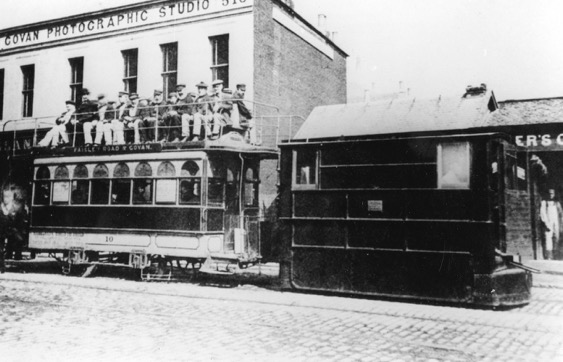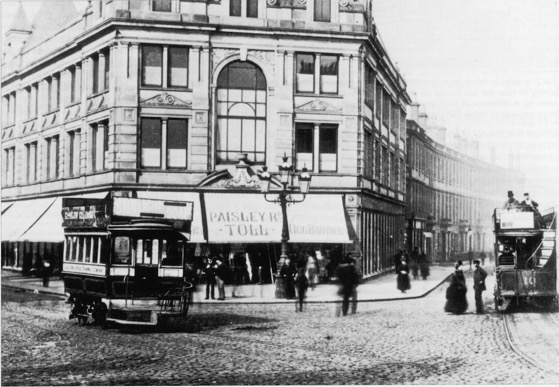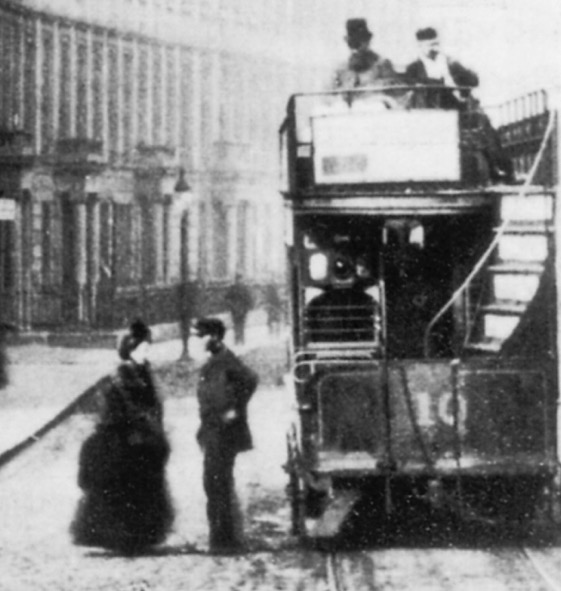Vale of Clyde Tramways
(Govan lines)
History
Powers to construct nearly 20 miles of tramway between Glasgow, Govan, Paisley and Johnstone, as well as between Port Glasgow, Greenock, Gourock and Ashton were granted on the 13th July 1871 under the Vale of Clyde Tramways Act, 1871. The act authorised the use of animal power (only), and also, the incorporation of a company, the Vale of Clyde Tramways Company, to build and operate the lines.
Of the Glasgow, Govan, Paisley and Johnstone lines, only that from Parkhouse Toll (later called Paisley Road Toll) to Linthouse was ever built. The geographically unconnected lines between Port Glasgow, Greenock, Gourock and Ashton are dealt with elsewhere (see link).
Construction of the company's Govan line, which was built to a gauge of 4ft 7¾ins, began in July 1872, services commencing some five months later on the 1st January 1873. The line was 2.28 miles long, and ran from Paisley Road Toll westwards along Govan Road to Linthouse. In later years, it was lengthened slightly due to the construction of Princes Dock, around which the line had to deviate.
The western end of the authorised line, between Paisley Road Toll and Morrison Street, a distance of just 0.3 miles, was actually in the City of Glasgow, and was not built by the company, but by Glasgow Corporation. This was because the latter was set upon owning, and therefore controlling, all tramway developments within the city, to which end it had succeeded in having a clause inserted into the company's 1871 Act giving it the right to take over the powers for this section within six months of the passing of the act, which it duly did. Services over this section — to and from St Vincent Place — commenced on the 17th December 1872, and were operated by the corporation's lessee, the Glasgow Tramways and Omnibus Company (GT&OCo).
Rather than go to the expense of purchasing tramcars and horses, the VofCTCo chose instead to lease operation of the line to the GT&OCo, services running right through from St Vincent Street to Linthouse. Whilst through running would undoubtedly have been a boon to the VofCTCo, as well as the passengers, it was destined not to last, the corporation eventually putting a stop to it. It is unclear when this happened, or why, but a possible date is the 2nd July 1874, when the VofCTCo took over operation themselves, using some horsecars borrowed from its Ashton to Gourock tramway, as well as two new ones. The horses were provided by a contractor, possibly the GT&OCo.
The corporation had in fact had its eyes on Govan for some time, and wished to incorporate the burgh into the City of Glasgow. Rather than wait until this could be achieved, which was in fact to take another 37 years, the corporation took the precautionary measure of ensuring that it had the right to take over the VofCTCo's Govan lines, should it be able to reach agreement with the company; these powers were granted on the 19th July 1875 under the Glasgow Corporation Tramways Act, 1875. The company, meanwhile, was now concentrating on acquiring powers to work the Govan tramway using mechanical power, these being granted on the 27th June 1876 under the Vale of Clyde Tramways Act, 1876.
Whilst permission was granted in 1875 for trial running of a prototype compressed air tram, mechanical traction was not used on regular services until August 1877, when steam trams made their bow, this being the first use of this form of traction on a street tramway anywhere in the British Isles. However, rather than working the services itself, with what was after all unproven technology, the company chose to enter into a three-year contract with the steam trams' manufacturer, Henry Hughes & Company of Leicester. Although the contract formally began on the 21st July 1877, the first services are not thought to have commenced until around the 20th August 1877.
The steam tram engines, of which there were ten by 1880, were driven by Hughes' men, conductors more than likely being in the employ of the VofCTCo. Hughes was not keen to continue after the end of his contract (20th July 1880), but was persuaded to commit to a further 12 months in exchange for an increase in the rate paid per mile. During this period, Hughes again indicated that he would not continue the arrangement beyond the end of his contract (20th July 1881), presumably because he wished to concentrate on his core business, which was engine manufacture. The VofCTCo meanwhile managed to procure ten Kitson engines (delivered over the course of 1881), but was still forced to hire some of Hughes' engines to ensure that enough motive power was available following the end of Hughes' contract.
Although the line was probably profitable, the company returns do not separate the Govan line from the those in Gourock and Greenock, so exactly how profitable it was is not clear. What is however clear, is that when the company was approached by the Govan Commissioners of Police — the local authority through whose area the tramway ran — most likely in 1892, it quickly reached agreement to sell the tramway.
It is likely that Govan Commissioners of Police, who already owned the neighbouring Glasgow and Ibrox Tramway, had been considering acquiring the tramway for some time, as they had the right — under the Tramways Act, 1870 — to compulsorily purchase the lines in Govan 21 years after the passing of the enabling act, which in this case would have been July 1892. Small portions of the steam tramway were, however, outside Govan, in the Burgh of Kenning Park and the County of Lanark, the Commissioners obtaining powers to buy these sections on the 29th June 1893, under the Govan Burgh (Tramways) Act, 1893. The tramway was handed over on the 9th July 1893, steam services ceasing that day, even though the Commissioners of Police were authorised to use mechanical traction; the following day saw the reintroduction of horse traction, as well as the return of the GT&OCo, which was already operating the Glasgow and Ibrox Tramway as the Commissioners of Police's lessee.
Tramway services were provided by the GT&OCo until the 11th November 1896, when Glasgow Corporation took over, the latter having bought the company out of its lease. The tracks finally passed into the hands of Glasgow on the 7th August 1912, when the Glasgow Boundaries Act, 1912, received its Royal Assent.
My thanks to Alan Brotchie and the late Morton Hunter for assistance with the early development of the Govan line.
Uniforms
The first services on the VofCTCo's Govan lines were horse drawn, and were operated, between 1873 and 1874, by the GT&OCo. Although no photographs of this early period appear to have survived, it is likely that tramcar crews wore the same attire as they did when working their main services within Glasgow (see link). Between 1874 and the commencement of steam services in 1877, it is unclear whether uniforms were worn, though in all probability they were not.
Although the VofCTCo operated steam-hauled services for around 16 years (1877 to 1893), only a single photograph appears to have survived that shows a tramwayman (a conductor) and even this is blurred; it does, however, suggest that informal attire was worn, at least during the period when the photograph was taken (between 1877 and 1881). Support for the wearing of informal attire also comes from the VofCTCo's other tramway, the geographically unconnected Greenock to Gourock section of the horse-drawn Greenock and Port Glasgow Tramway (see link), which it operated between 1873 and 1894.
Steam tram drivers on the VofCTCo's Govan lines, who were presumably employed by Henry Hughes from 1877 to 1881, and by the company itself from 1881 to 1893, probably wore railway footplate-like attire (cotton jackets and trousers), as this was very much the norm for steam-tram operation in the UK.
Photographs of senior staff have not survived, so it is impossible to say whether or not they wore uniforms.
Following the acquisition of the tramway by Govan Commissioners of Police on the 9th July 1893, services were once again horse drawn, the lessee being the GT&OCo; staff working these services would have worn the uniforms of that company (see link).
Following the purchase of the Govan lease by Glasgow Corporation on the 11th November 1896, the tramway was operated by Glasgow Corporation Tramways, tramcar crews wearing the uniforms of that operator (see link).
Further reading
For a short history of the Vale of Clyde Tramway Company's Govan lines, see: 'The Glasgow Horse Tramways' by Struan Jno T Robertson; Scottish Tramway and Transport Society (2000).
Images
Steam tram drivers and conductors
One of only a handful of surviving photographs of a VofCTCo steam tram (a Hughes locomotive) and trailer (No 10), and the only one known to show a crew member. The conductor is standing on the rear platform, and although blurred, magnification suggests that only informal attire was worn. Photograph taken between 1877 and 1881. Author's Collection.
Glasgow and Ibrox Tramways Horsecar No 2 at Paisley Road Toll (on the left), with Vale of Clyde Tramways Company Steam Trailer Car Number 10 (on the right) — photograph purportedly taken in the late 1880s. Photo courtesy of the Tramways and Light Railway Society, with thanks to David Voice.
An enlargement of the above photograph showing a man who may or may not be a VofCTCo conductor; either way, it is impossible to say what he is wearing.